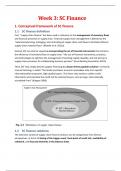Samenvatting
Summary of Supply Chain Strategy_SC Design-Finance_325240-M-6
- Instelling
- Tilburg University (UVT)
Summary of the two articles: o Zhao, Lima, and Arnd Huchzermeier. "Supply chain finance. (Chapter 6)". In Supply chain finance. Springer, Cham, 2018. 105-119. o Chen, Tao, et al. "Finance and firm volatility: Evidence from small business lending in China." Management Science (2021).
[Meer zien]




